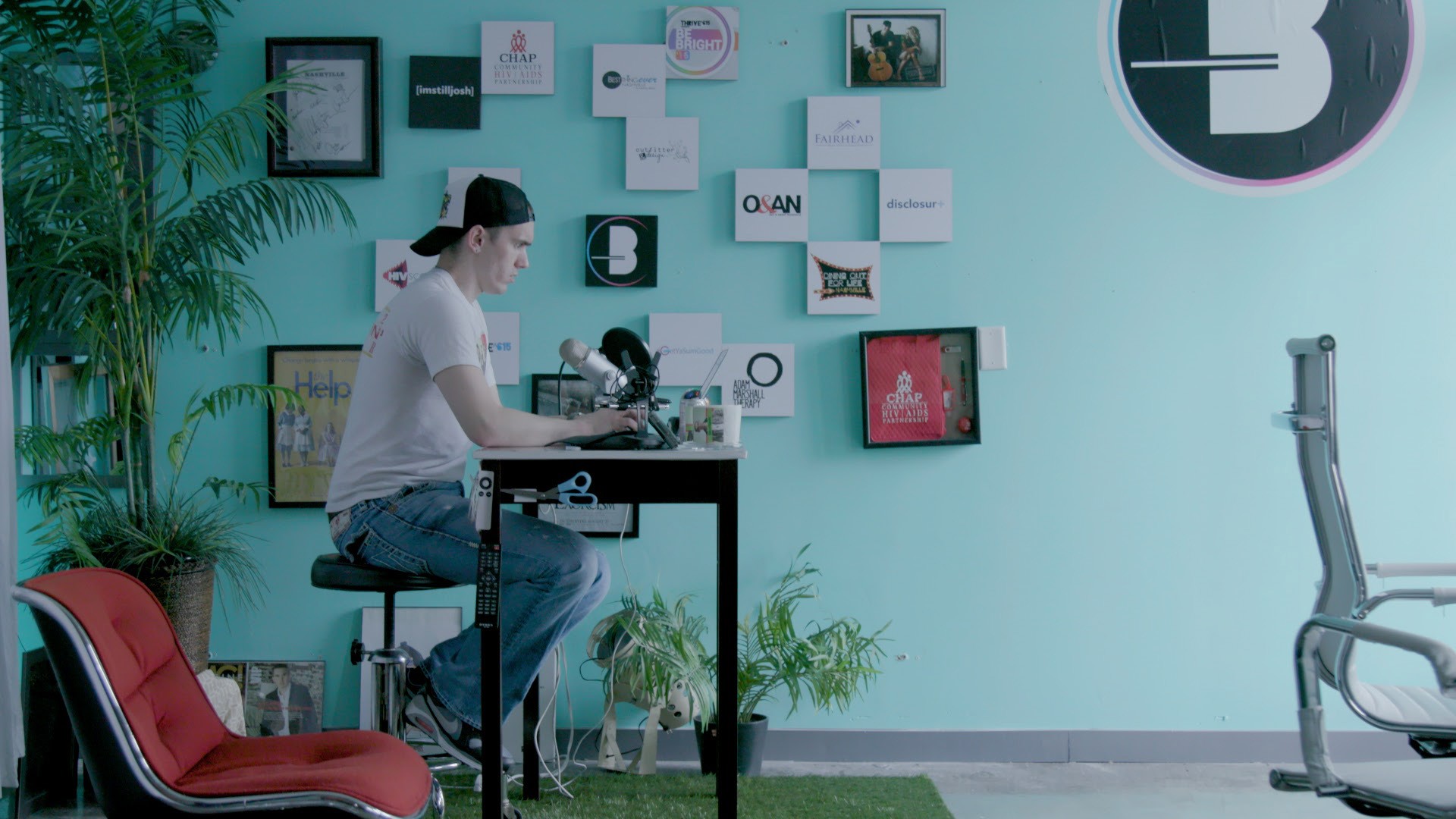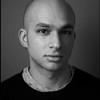Rudy Miles (L) and John Young at the GMHC offices in New York. Photo by the author
John Young was diagnosed with HIV in 1988. He was living in Washington, DC, at the time, and all around him were signs of death. It was the height of the AIDS crisis. Fear and misinformation ran rampant, and his friends were entering hospitals and dying within weeks or days."I thought I was going to die the day after I found out," Young says. "I was giving away all of my possessions to my best friend in DC, because I didn't think I was going to live until the end of the week."Today, Young is a healthy-looking 54-year-old living in New York, one of thousands of people living with HIV well into their 50s, 60s, and 70s. For many, advances in treatment have transformed a once-devastating disease into a maintenance condition, closer in scope to diabetes than the terminal illness it once was. In 1996, a 20-year-old infected with HIV could expect to live an average of 19 years. By 2013, researchers found that the average lifespan for HIV-infected North Americans had increased to 63.But that medical miracle presents an unexpected challenge for folks like Young: Older people living with HIV can often feel isolated, leading to a host of mental health problems. That's compounded by the fact that stigma surrounding the virus still abounds, even as social acceptance of LGBTQ people has increased.That's where the Buddy Program comes in. In 2015, Gay Men's Health Crisis (GMHC), one of New York's oldest and largest LGBTQ nonprofits, relaunched the Buddy Program, which had been dormant since 2005. The program matches volunteers with HIV-positive people looking for companionship, emotional support, or just someone to talk to about HIV and other things in their life.Young entered the program about a year ago. He asked GMHC coordinator Susan Rowley for a buddy who was a gay man and preferably African American like himself. After a few weeks, Rowley found Rudy Miles, a 50-year-old makeup artist and GMHC volunteer.Miles met Young for the first time on a summer day at a burger restaurant in Harlem."I fell in love with him… platonic love," Young says. "We talked about everything. Just talked and talked and talked. We went way past the recommended hour.""I just could not fathom that there are people who have no one in their lives that they could be with in a way that's meaningful for them," Miles says.Miles and Young meet or talk on the phone about once a week now."We talk a lot about childhood, family, traveling," Miles says. "It's so effortless to be together, even though we're so different."Miles and Young agreed that the structure of the program—the fact that they didn't know each other beforehand, that they have a commitment to talk once a week, that they're there specifically to talk and not as a date—made it easier to get to know each other, and talk about deeply personal issues.Young had been in a similar buddy program decades ago in DC, run by the Whitman-Walker health clinic. In the late 80s and early 90s, that program and GMHC's program had a much different focus: They were essentially end-of-life care programs, helping HIV-infected patients navigate healthcare systems and deal with the stigma of the disease. Young says that while HIV healthcare has vastly improved and he's been able to live a full life as a gay rights activist since, the stigma still affects him."Partnering was hard. It's still hard. You get lonely," Young says. "Sometimes I think my life, and people like me, our lives are invisible to everyone else. The media and everyone thinks everything was solved after gay marriage."
Watch a Daily VICE short about the blogger chronicling his life with HIV:
In 2013, the CDC estimated that 42 percent of Americans with HIV are over 50; by the end of this decade, that number will likely climb above 50 percent. Studies have shown that living with the virus as an older person can bring a slew of other negative effects on one's health. A 2006 study by the HIV nonprofit ACRIA found that over half of HIV-positive people over 50 suffer from depression; many more are affected by conditions like arthritis, hepatitis, and hypertension. The study also found that those living with HIV were often scared to talk about it with their friends, family, and healthcare providers.A separate study in the same year performed by Charles Emlet, a social work professor at the University of Washington Tacoma, found over two-thirds of older adults living with HIV face disproportionate levels of ageism and stigma in the healthcare system. The best solutions to both, Emlet says, were increasing "mastery" of knowledge about the disease and how to treat it among those infected and finding social support.Emlet and others also pointed to a growing group of older, newly diagnosed LGBTQ people, grappling with HIV for the first time in their 50s or 60s."They're thinking all the same thoughts—can I tell someone, what are they going to think about it, will I be able to date again?" says Christian Grov, a professor of community health at the CUNY Graduate School of Public Health and Health Policy who has studied HIV in older populations. "The meaning behind being diagnosed with HIV has changed a lot over the last 30 years, but it still carries a tremendous amount of stigma."GMHC's buddy program is relatively small; according to representatives, about 22 pairs are currently matched up, with a few more in the works. But it's just one example of how social services for the growing population of elderly LGBTQ Americans are expanding nationwide, from newer nonprofits to the increasing number of LGBTQ senior homes opening to address demand for affordable housing."One of the things we realized time and time again was the need to support long-term survivors," says Kelsey Louie, who decided to bring back the Buddy Program shortly after becoming GMHC's director in 2014. "Older people have unique emotional and psychological needs that are often overlooked."Like Zaidannahij Annahij, 55, who felt overlooked for years as his friends and lovers died from HIV."Like 30 of my sex friends died, and six of my lovers died, and I never got to replace them," he says. "I didn't find people. I couldn't connect to younger generations."In 2015, Annahij lost his Brooklyn apartment of 25 years due to a rent increase, and moved into the New York City shelter system. He said he felt depressed and lonely. GMHC matched him up with Aurelio Rapp, a 31-year-old working at Barnes and Noble and going to school for social work. They clicked instantly. They'd talk about art, go to museums, and walk in parks together."We're very similar in that we can find art in anything—from a painting, to a movie, to a TV show, to garbage on the floor," Rapp says.Annahij said there's a big difference between having a friend and having a buddy. Because Rapp's a volunteer, not a random person, Annahij feels like can tell Rapp anything. Friends come with baggage. Buddies don't."I needed a buddy," he says. "You can't live life alone. You can die from loneliness. This saved my life."Follow Peter Moskowitz on Twitter .
Advertisement
Advertisement
Advertisement
Watch a Daily VICE short about the blogger chronicling his life with HIV:

In 2013, the CDC estimated that 42 percent of Americans with HIV are over 50; by the end of this decade, that number will likely climb above 50 percent. Studies have shown that living with the virus as an older person can bring a slew of other negative effects on one's health. A 2006 study by the HIV nonprofit ACRIA found that over half of HIV-positive people over 50 suffer from depression; many more are affected by conditions like arthritis, hepatitis, and hypertension. The study also found that those living with HIV were often scared to talk about it with their friends, family, and healthcare providers.A separate study in the same year performed by Charles Emlet, a social work professor at the University of Washington Tacoma, found over two-thirds of older adults living with HIV face disproportionate levels of ageism and stigma in the healthcare system. The best solutions to both, Emlet says, were increasing "mastery" of knowledge about the disease and how to treat it among those infected and finding social support.Emlet and others also pointed to a growing group of older, newly diagnosed LGBTQ people, grappling with HIV for the first time in their 50s or 60s."They're thinking all the same thoughts—can I tell someone, what are they going to think about it, will I be able to date again?" says Christian Grov, a professor of community health at the CUNY Graduate School of Public Health and Health Policy who has studied HIV in older populations. "The meaning behind being diagnosed with HIV has changed a lot over the last 30 years, but it still carries a tremendous amount of stigma."
Advertisement
